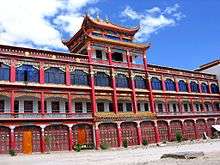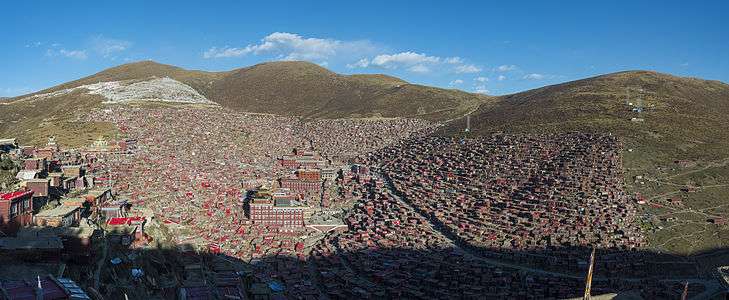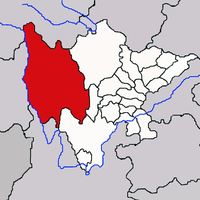Garzê Town
| Garzê | |
|---|---|
| Township | |
| Tibetan transcription(s) | |
| • Tibetan | དཀར་མཛེས་ |
| • Wylie transliteration | dkar mdzes |
| Chinese transcription(s) | |
| • Traditional | 甘孜 |
| • Pinyin | Gānzī |
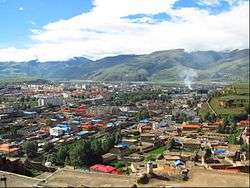 | |
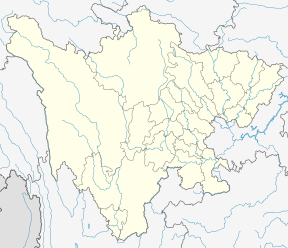 Garzê Location in Sichuan | |
| Coordinates: 31°38′4″N 99°59′7″E / 31.63444°N 99.98528°ECoordinates: 31°38′4″N 99°59′7″E / 31.63444°N 99.98528°E | |
| Country | China |
| Province | Sichuan |
| Prefecture | Garzê Tibetan Autonomous Prefecture |
| County | Garzê County |
| Population (2010)[1] | 16,920 |
| Time zone | UTC+8 (CST) |
Garzê or Gānzī (Tibetan: དཀར་མཛེས་ Kandze),[2] is a town and county seat in Garzê County, Garzê Tibetan Autonomous Prefecture in western Sichuan Province, China. Despite Garzê Prefecture being named after the town, the prefecture capital is actually Kangding, 365 km to the southeast. As of 2010, Garzê was home to 16,920 inhabitants. Garzê is an ethnic Tibetan township and is located in the historical Tibetan region of Kham. It contains the 15th century Kandze Monastery, home to over 500 Gelugpa monks.[3]
Geography
Garzê lies in the large Garzê valley at 3390 metres above sea level and is surrounded by rocky terrain and mountains.[4] The Yalong River's tributary Rongcha River passes through the town from north to south.
Landmarks
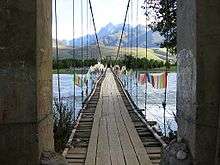
The traditional Tibetan customs of Garzê still remain despite now being part of Sichuan and the town and county contains many Tibetan villages and monasteries (gompas). The largest monastery is Garzê Monastery, an imposing monastery 540 years old as of 2008 which looms over the town from the north, and contains over 500 monks belonging to the Gelug sect of Tibetan Buddhism. The monastery was partly destroyed by the Chinese during the Cultural Revolution but was rebuilt in the Han-Chinese-style and today displays a fusion of old Tibetan and Chinese architecture. It is located in the western Tibetan quarter of the town. On 26 November 2017, Tibetan monk Tenga from Kardze Monastery set himself on fire and called for the freedom of Tibet before he died.[5] Also of note is Den Monastery, which is much smaller but more traditional to the south of the town and Dontok Monastery, located some kilometres outside the town over a suspended bridge over the Yalong River. Dontok is a recent building under construction but displays notable white, grey and crimson stripes on the walls. Dingkhor Chorten is also located in the eastern suburbs of Garzê on a small hill which also contains a temple housing a Buddhist library.
The main street is Chuanzang Road. Small shops downtown provide typical Tibetan clothing and jewellery and accessories needed by the herdmen frequenting the town.A number of stores sell antiques, monk's garments and religious artefacts and traditional Tibetan hand-carved furniture. Supermarkets on the main street sell food and toiletries and bottles of beer and Chinese wine.
Gallery
Footnotes
- ↑ City Population. "Gānzī Zhèn (Gānzī Xiàn)". Retrieved 22 March 2017.
- ↑ Dorje (1999), p. 496.
- ↑ Mayhew and Kohn (2005), p. 254.
- ↑ "Ganzi". Chinadiscover.net. Retrieved December 11, 2009.
- ↑ Choephel, Lobsang; Ngodup, Pema; Dolma, Dawa; Finney, Richard (29 November 2017). "Tibetan Monk Burns to Death in Sichuan Calling For Tibetan Freedom". Radio Free Asia. Archived from the original on 7 March 2018. Retrieved 2018-03-16.
A Tibetan monk set himself ablaze and died on Sunday in western China’s Sichuan province in a challenge to Chinese rule in Tibetan areas, Tibetan sources said. The protest brings to 151 the number of self-immolations by Tibetans living in China since the wave of burnings began in 2009. Tenga, aged 63 and a monk at a monastery in Sichuan’s Kardze (in Chinese, Ganzi) county, set himself alight on Sunday, Nov. 26, and died of his burns, a Tibetan living in exile in South India told RFA’s Tibetan Service, citing sources in Kardze. While burning, Tenga called out for freedom for Tibet, a second source said, speaking on condition of anonymity from inside Tibet. (...) 'But what we know for sure is that he burned himself for the Tibetan cause, and that he demanded freedom for Tibet,' he said. The second of four siblings in his family, Tenga had worked as a volunteer teacher before joining the Kardze monastery, another local source said. 'He was very popular in several villages in his hometown, where he was respectfully called ‘Teacher’ by the villagers,' the source said.
References
- Dorje, Gyurme (1999). Footprint Tibet Handbook with Bhutan. 2nd Edition. Footprint Handbooks, Bath, England. ISBN 1-900949-33-4.
- Forbes, Andrew ; Henley, David (2011). China's Ancient Tea Horse Road. Chiang Mai: Cognoscenti Books. ASIN: B005DQV7Q2
- Leffman, David, et al. (2005). The Rough Guide to China. 4th Edition. Rough Guides, New York, London, Delhi. ISBN 978-1-84353-479-2.
- Mayhew, Bradley and Michael Kohn. (2005). Tibet. 6th Edition. Lonely Planet. ISBN 1-74059-523-8.
External links
| Wikimedia Commons has media related to Ganzi. |
- Garzê at Baidu (in Chinese)
- Hudong Encyclopedia (in Chinese)





